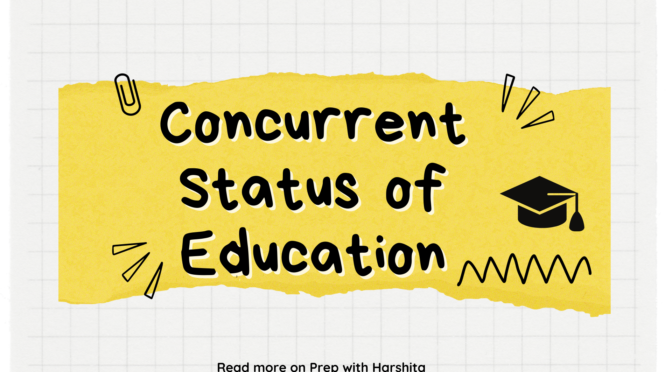The concurrent status of education in India refers to the division of legislative powers between the central government and state governments concerning matters related to education. Under the Constitution of India, education is listed in the concurrent list, which means that both the central government and state governments have the authority to make laws and policies regarding education.
In India, the education sector falls under the concurrent list of the Constitution. The concurrent list consists of subjects on which both the central government and the state governments have the power to legislate. This means that both the central and state governments can make laws and policies related to education.
Under the concurrent status of education, the central government has the authority to formulate and implement policies and laws at the national level, while the state governments have the responsibility to govern and regulate education within their respective states. This arrangement allows for a shared responsibility in the field of education, with the central government providing overall guidelines and policies, and the state governments adapting and implementing them according to the specific needs and context of their regions.
Here’s a detailed explanation of the concurrent status of education:
- Legislative Authority: The central government, represented by the Parliament of India, and the state governments, represented by their respective legislative bodies, have the power to enact laws related to education. Both levels of government can introduce bills, debate them, and pass legislation on various aspects of education.
- Shared Responsibility: The concurrent status of education recognizes that education is a shared responsibility between the central government and state governments. While the central government sets overall policies and guidelines, the state governments have the flexibility to adapt and implement them based on local needs, context, and resources.
- Harmonization of Laws: The Constitution provides that in case of any conflict between a central law and a state law on a matter in the concurrent list, the central law prevails. However, state laws can still be in force if they receive the President’s assent. This ensures coordination and uniformity in education-related legislation across the country.
- Collaboration and Coordination: The concurrent status allows for collaboration and coordination between the central government and state governments in formulating and implementing education policies. There are regular consultations, discussions, and joint initiatives to exchange ideas, share best practices, and work towards common goals in the education sector.
- Areas under Concurrent Jurisdiction: The concurrent status of education covers several areas, including curriculum and syllabus, teacher education and training, educational standards, infrastructure norms, vocational education, adult education, and other aspects of education. Both the central and state governments have the authority to make policies and regulations in these areas.
- Financial Implications: While the central government provides financial support and schemes for the education sector, the state governments also contribute to funding education within their jurisdictions. Financial allocations and grants from the central government are utilized by states to implement educational initiatives, improve infrastructure, and enhance the quality of education.
- Monitoring and Evaluation: The concurrent status also involves monitoring and evaluation mechanisms to ensure compliance with laws, policies, and standards. Both the central and state governments have responsibilities in monitoring educational institutions, assessing educational outcomes, and addressing any issues or deficiencies that arise.
Some key areas that fall under the concurrent status of education include:
- Curriculum and Pedagogy: The central government plays a role in setting broad national curriculum frameworks and guidelines, while the state governments have the flexibility to adapt and implement them at the state level. States can make modifications to the curriculum to align it with regional and local needs.
- Teacher Education and Training: The central government formulates policies and standards for teacher education and training, including the establishment of national-level institutions. However, state governments are responsible for the implementation and management of teacher education programs within their respective states.
- Standards and Quality Assurance: The central government sets overall standards and guidelines for maintaining quality in education, such as infrastructure requirements, pupil-teacher ratios, and assessment frameworks. State governments are responsible for ensuring compliance with these standards and monitoring the quality of education in schools within their jurisdictions.
- Funding and Financial Support: While both the central and state governments contribute to funding education, the central government plays a significant role in providing financial support to states through various schemes, grants, and centrally sponsored programs. These funds are utilized by states for implementing educational initiatives and addressing specific needs.
Also Visit: Prep with Harshita

Also Read: Parenting Styles and Impact


Thank you! So much Harshita Ma’am, your notes are very helpful and easy to understand. You have used very simple language and it helped me a lot in understanding this chapter. I’ve watched lots of videos on YouTube but nothing worked. Thank you for your efforts.
Yours lovingly
Puja Rai